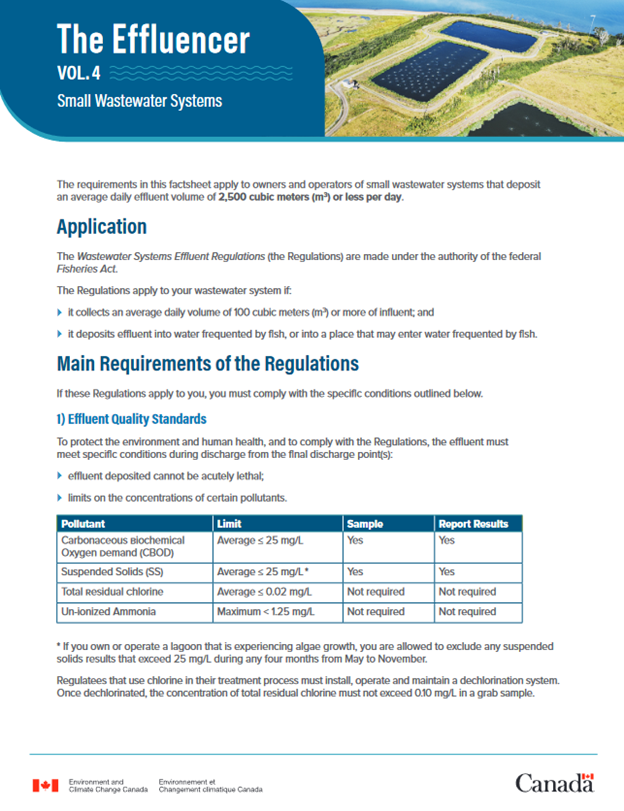Small wastewater systems

Download the alternative format
(PDF format, 818 KB, 3 pages)
The requirements in this factsheet apply to owners and operators of small wastewater systems that deposit an average daily effluent volume of 2,500 cubic meters (m3) or less per day.
Application
The Wastewater Systems Effluent Regulations (the Regulations) are made under the authority of the federal Fisheries Act.
The Regulations apply to your wastewater system if:
- it collects an average daily volume of 100 cubic meters (m3) or more of influent and
- it deposits effluent into water frequented by fish, or into a place that may enter water frequented by fish
Main requirements of the regulations
If these Regulations apply to you, you must comply with the specific conditions outlined below.
1) Effluent quality standards
To protect the environment and human health, and to comply with the Regulations, the effluent must meet specific conditions during discharge from the final discharge point(s):
- effluent deposited cannot be acutely lethal
- limits on the concentrations of certain pollutants
| Pollutant | Limit | Sample | Report Results |
|---|---|---|---|
| Carbonaceous biochemical oxygen demand (CBOD) | Average ≤ 25 mg/L | Yes | Yes |
| Suspended solids (SS) | Average ≤ 25 mg/L* | Yes | Yes |
| Total residual chlorine | Average ≤ 0.02 mg/L | Not required | Not required |
| Un-ionized ammonia | Maximum < 1.25 mg/L | Not required | Not required |
* If you own or operate a lagoon that is experiencing algae growth, you are allowed to exclude any suspended solids results that exceed 25 mg/L during any four months from May to November.
Regulatees that use chlorine in their treatment process must install, operate and maintain a dechlorination system. Once dechlorinated, the concentration of total residual chlorine must not exceed 0.10 mg/L in a grab sample.
Acute lethality testing is not required for systems depositing less than 2,500 m3 per day. However, if you do perform acute lethality testing, all results must be submitted and acute lethality test failures must be reported without delay to the prescribed authority in your province or territory.
2) Volume and effluent monitoring and reporting
Under the Regulations, you are required to:
- submit, and keep up-to-date, an identification report for your wastewater system
- sample wastewater effluent
- monitor effluent volume with method required for your system type, either:
- by using monitoring equipment; or
- by using a method of estimation based on generally accepted engineering practices with a margin of error of ± 15%
- submit monitoring reports with effluent volume, number of days that effluent was deposited, average concentrations of CBOD and SS, and acute lethality results (if applicable)
Sampling and reporting frequencies as well as method of volume determination vary depending on the type of wastewater system:
System type: mechanical plant or outfall
- Discharge frequency: continuous
- Sampling frequency : monthly, at least 10 days after previous sample
- Reporting frequency: quarterly
- If your system was issued a transitional authorization, you follow the same sampling and reporting frequencies as continuously discharging lagoons
- Volume determination: using monitoring equipment
- If your system was issued a transitional authorization, you can use a method of estimation
System type: lagoon
- Discharge frequency: continuous
- Sampling frequency : quarterly, at least 60 days after previous sample
- Reporting frequency: annually
- Volume determination: using monitoring equipment
- If your system was issued a transitional authorization, you can use a method of estimation
System type: lagoon
- Discharge frequency: intermittent
- Sampling frequency :
- Once at discharge, if discharge 30 days or less
- Once every two weeks, at least seven days after the previous sample, if discharge is more than 30 days
You can use the results of a sample that was taken directly in the lagoon two weeks or less before discharge, if the sample was collected to meet a federal or provincial requirement. This sample would count as your first sample during the first 30 days of sampling.
- Reporting frequency: annually
- Volume determination: using monitoring equipment or method of estimation
Sampling directly in lagoon
If you own or operate a lagoon (intermittent or continuous), sampling can be done at a location other than the final discharge point if:
- Representative effluent samples can be collected and
- A licensed professional specifies in a document where and how to sample
3) Reporting information
- Annual reports are due 45 days after the end of the calendar year (February 14 of each year)
- Quarterly reports are due 45 days after the end of the quarter (February 14, May 15, August 14, and November 14 of each year)
- You must create the report in the Effluent Reporting Information System (ERRIS) via the Single Window Information Manager (SWIM)
- Paper reporting forms are available and can be sent upon request
4) Record Keeping
You must keep all related records on site for a minimum of five years.
For more information on the Regulations, please visit Wastewater website.
For support with regulatory requirements, sampling guidance and reporting, please contact eu-ww@ec.gc.ca.
For Indigenous communities, please contact your regional ECCC representative:
Pacific and Yukon : promcon-py-compro@ec.gc.ca
Prairie and Northern : ec.promconrpn-compropnr.ec@ec.gc.ca
Ontario : ec.promcon-on-compro.ec@ec.gc.ca
Quebec : eu-qc-ww@ec.gc.ca
Atlantic : promo-atl-compro@ec.gc.ca
Disclaimer
This information does not in any way supersede or modify the Wastewater Systems Effluent Regulations or the Fisheries Act, or offer any legal interpretation of those Regulations or Act. Where there are any inconsistencies between this information and the Regulations or Act, the Regulations or Act take precedence, respectively. A copy of the Wastewater Systems Effluent Regulations is available for your reference.
Page details
- Date modified: